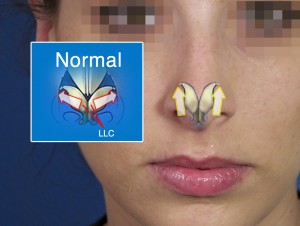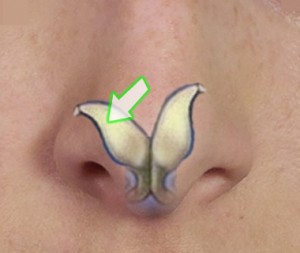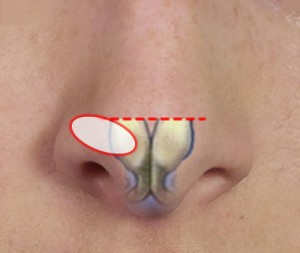Many rhinoplasty candidates may hear they have what are called cephalically oriented lower lateral cartilages, or cephalic orientation of their tip cartilage. Cephalic orientation of the nasal tip cartilage is a common occurrence and source of patients seeking rhinoplasty surgery. In fact, this problem accounts for a significant number of patients who have a bulbous nasal tip. This case example presented here demonstrates features of this very common abnormality and highlights one of the more usual techniques I use to address this issue while creating a natural looking nasal tip.
Cephalic Orientation of Cartilage Assessment
![]() This young lady from San Diego presented to my office requesting primarily reshaping of her nasal tip region. Her main complaint was that her nose appeared poorly defined in the tip region. She also desired to have her bridge reshaped. But her main concern at the time was how her nasal tip lacked definition.
This young lady from San Diego presented to my office requesting primarily reshaping of her nasal tip region. Her main complaint was that her nose appeared poorly defined in the tip region. She also desired to have her bridge reshaped. But her main concern at the time was how her nasal tip lacked definition.
On examination, if you look at her frontal view, you can see that her tip region is, indeed, quite bulbous. In other words, it is more rounded and lacking in terms of definition. In this particular case, the tip appeared more bulbous because she had cephalically oriented lower lateral cartilages. The lower lateral cartilage (or lateral crus cartilage) refer to the side wings of the paired cartilage structures that largely comprise the nasal tip.  These are referenced as LLC in the adjacent diagram. As you can see in the diagram, normally the lateral crus extends out to the side of the tip in a more horizontal vector or direction. In doing so, this provides the tip with proper shape and definition. A more cephalic orientation means that the lateral crus instead is directed in a more vertical orientation (cephalic referring to the top of the head) as it leaves the midline of the nose. You can see this more visually in the adjacent diagram where this patient’s lateral crus cartilage extends upward instead of going out to the side. Consequently, there is more cartilage volume in this area of the tip that makes it appear more bulbous and less defined. In addition to the bulbous nasal tip, her columella (the column that is positioned between the nostrils) is somewhat heavy – meaning it is somewhat prominent. Overall, she desired to have a more feminine looking nasal tip, which is a very common request among cosmetic rhinoplasty candidates in my practice.
These are referenced as LLC in the adjacent diagram. As you can see in the diagram, normally the lateral crus extends out to the side of the tip in a more horizontal vector or direction. In doing so, this provides the tip with proper shape and definition. A more cephalic orientation means that the lateral crus instead is directed in a more vertical orientation (cephalic referring to the top of the head) as it leaves the midline of the nose. You can see this more visually in the adjacent diagram where this patient’s lateral crus cartilage extends upward instead of going out to the side. Consequently, there is more cartilage volume in this area of the tip that makes it appear more bulbous and less defined. In addition to the bulbous nasal tip, her columella (the column that is positioned between the nostrils) is somewhat heavy – meaning it is somewhat prominent. Overall, she desired to have a more feminine looking nasal tip, which is a very common request among cosmetic rhinoplasty candidates in my practice.
![]() Her preoperative side view reveals a slight convexity (roundness) to the bridge contour as indicated by the red curved line over the dorsum. In addition, this view confirms the somewhat heavy columella as indicated by the red curved line under the tip of the nose. Granted, the convexity of the bridge is not real dramatic. Yet, this was enough to bother the patient and warrant some type of cosmetic change. In terms of the heavy columella, this type of deformity contributes to what is often referred to as ‘excess columella show’ – which means you can see more of the inner lining of the nose than desired from this side view.
Her preoperative side view reveals a slight convexity (roundness) to the bridge contour as indicated by the red curved line over the dorsum. In addition, this view confirms the somewhat heavy columella as indicated by the red curved line under the tip of the nose. Granted, the convexity of the bridge is not real dramatic. Yet, this was enough to bother the patient and warrant some type of cosmetic change. In terms of the heavy columella, this type of deformity contributes to what is often referred to as ‘excess columella show’ – which means you can see more of the inner lining of the nose than desired from this side view.
When combined with a bulbous nasal tip, these cosmetic issues can add up – really prompting patients to seek out some type of change in the form of rhinoplasty surgery.
Natural Bulbous Tip Surgery
After consulting with her in my office, we decided to proceed with an open cosmetic rhinoplasty approach with the main emphasis on reshaping her cephalically oriented cartilage and bulbous nasal tip. The open rhinoplasty approach afforded me optimal exposure of her nasal tip cartilage, which was the crux of what we were doing in terms of surgical reshaping. In the process, I did perform some bridge reshaping in the form of conservative hump reduction. Because the bridge height was reduced, I ended up breaking her bones to move them in slightly – not necessarily to narrow her nose but more to maintain a natural bridge width. I then focused on her nasal tip region.
It should be pointed out, there are a wide variety of rhinoplasty techniques that can be used to correct a bulbous nasal tip. In fact, these different techniques are reviewed in my other rhinoplasty tutorial chapters. Ultimately, the choice of technique really distills down to your surgeon’s experience and preference in terms of what works best in their hands. In this case example, I chose to deconstruct (take apart) her nasal tip, move it into a new location, and reconstruct the cartilage to create a new tip.  In doing so, I first had to detach the lateral crus from its current location, which involves meticulous technique in separating the delicate cartilage wings from the surrounding structures. The cartilage is then moved down and outward to approximate a more normal configuration and position. This is shown more visually in the adjacent diagram where you can see how one side of the lateral crus cartilage was detached and reoriented out to the side (see green-bordered arrow). Comparing the two sides, you can really see the difference in terms of cephalic orientation and normal positioning of the lower lateral cartilage. The lateral crus cartilage is then anchored in the new location with use of fine sutures to help hold it in place long-term. In this case, I also had to narrow the distance between the lower lateral cartilages in order to provide even more tip definition. During these maneuvers, I also reshaped the front edge of her septum and reoriented the adjacent cartilage to correct her heavy columella.
In doing so, I first had to detach the lateral crus from its current location, which involves meticulous technique in separating the delicate cartilage wings from the surrounding structures. The cartilage is then moved down and outward to approximate a more normal configuration and position. This is shown more visually in the adjacent diagram where you can see how one side of the lateral crus cartilage was detached and reoriented out to the side (see green-bordered arrow). Comparing the two sides, you can really see the difference in terms of cephalic orientation and normal positioning of the lower lateral cartilage. The lateral crus cartilage is then anchored in the new location with use of fine sutures to help hold it in place long-term. In this case, I also had to narrow the distance between the lower lateral cartilages in order to provide even more tip definition. During these maneuvers, I also reshaped the front edge of her septum and reoriented the adjacent cartilage to correct her heavy columella.
In situations like this where the patient had no prior history of rhinoplasty surgery, it is important to choose a technique that largely preserves the native cartilage framework of the nose. In other words, it is preferable to avoid techniques that involve cutting the cartilage, or even worse, removing a lot of the lower lateral cartilage for the sake of trying to create a more defined tip. By avoiding cutting the cartilage, you can often times maximize chances you will create a more natural looking nasal tip.
 This concept is reinforced in the adjacent diagram that shows what happens when a rhinoplasty surgeon comes in and simply cuts the perceived ‘excess’ cephalic cartilage. If you transect or cut this cartilage out as shown by the dashed red line, you now leave only a fraction of the lower lateral cartilage intact to provide support to the sides of the tip. As you can easily appreciate, there is now a fair amount of cartilage missing (indicated by the outlined oval region that should be the repositioned segment of cartilage) that should normally be there. The remaining amount of cartilage left over is grossly insufficient to maintain proper support and shape of the nasal tip. This means that the sides of the nasal tip will begin to slowly collapse as time goes on. This unfortunate outcome is not something that is typically seen within the first few months of rhinoplasty recovery. It actually takes more time – on the order of many months – to become more visible. By that time, scarring has taken place and the dreaded pinched nasal tip becomes more apparent. In many cases, this type of problem forces patients to have a complex revision rhinoplasty to correct the defect.
This concept is reinforced in the adjacent diagram that shows what happens when a rhinoplasty surgeon comes in and simply cuts the perceived ‘excess’ cephalic cartilage. If you transect or cut this cartilage out as shown by the dashed red line, you now leave only a fraction of the lower lateral cartilage intact to provide support to the sides of the tip. As you can easily appreciate, there is now a fair amount of cartilage missing (indicated by the outlined oval region that should be the repositioned segment of cartilage) that should normally be there. The remaining amount of cartilage left over is grossly insufficient to maintain proper support and shape of the nasal tip. This means that the sides of the nasal tip will begin to slowly collapse as time goes on. This unfortunate outcome is not something that is typically seen within the first few months of rhinoplasty recovery. It actually takes more time – on the order of many months – to become more visible. By that time, scarring has taken place and the dreaded pinched nasal tip becomes more apparent. In many cases, this type of problem forces patients to have a complex revision rhinoplasty to correct the defect.
But why would a rhinoplasty surgeon simply cut out the cartilage instead of reorienting it? In some cases, it is because the rhinoplasty surgeon is just not experienced enough in this type of surgery to know any better. In other cases, it is because they are not using an open approach – instead, they are using a closed rhinoplasty approach, which means they do not have the type of exposure necessary to perform this type of repositioning and reorientation of the lower lateral cartilage. The only alternative they have with a closed approach is to reduce the cartilage contributing to the bulbous look – by cutting it out. This is why it is so important that patients only seek out experts in rhinoplasty surgery when they are dealing with a bulbous nasal tip related to cephalic orientation of the lateral crus cartilage. Experts who perform this type of cosmetic nose reshaping on a regular basis, like myself, are much better prepared to offer you a more reliable method of surgical correction that will minimize chances of you having to undergo a revision rhinoplasty procedure.
Bulbous Tip Rhinoplasty Photos
This patient’s actual before and after photos are provided here for a comparison view.
As you can see, this patient now has a nasal tip that does not appear bulbous. In fact, her nasal tip now looks well defined with a much more feminine overall shape. Her cephalically positioned cartilage has been successfully contoured to be more horizontally oriented with improved shape. You can also appreciate how the columella has been lifted up to create a less heavy look. Furthermore, as seen best on the oblique and side views, her bridge has been smoothed out as a result of reducing the bridge height. Collectively, these very careful surgical changes have resulted in a nose that appears much more shapely and defined – yet looks quite natural and fitting for her facial features.
Bulbous Tip Rhinoplasty Consult
If you have a bulbous nasal tip with cephalic orientation of the lower lateral cartilages, contact my office today to schedule a personalized consultation with one of the regions best rhinoplasty experts.


